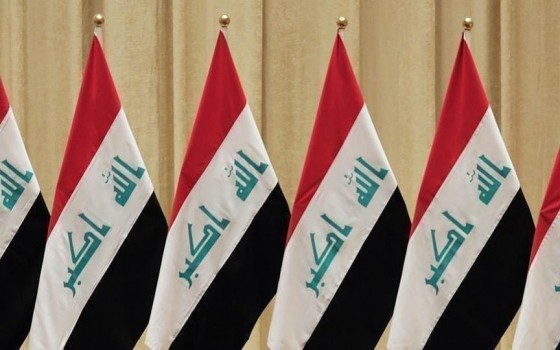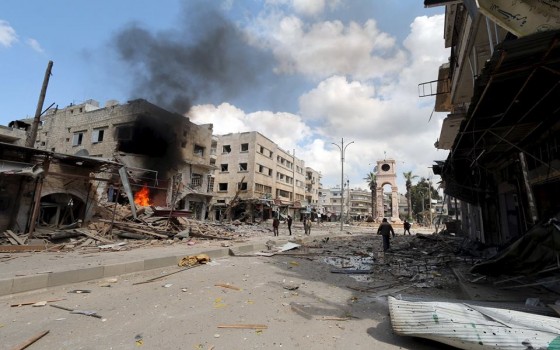
Palestine: Massive risks of unexploded ordnance, unprecedented debris from war, and challenges in proving ownership

- Europe and Arabs
- Thursday , 30 January 2025 8:9 AM GMT
Gaza - New York: Europe and the Arabs
The Director of the United Nations Mine Action Service (UNMAS) in the occupied Palestinian territory, Luke Irving, warned that the threat of explosive ordnance in Gaza and the West Bank is present and affects the lives of civilians and the delivery of humanitarian assistance, including since the start of the ceasefire in Gaza. According to the UN daily news bulletin, a copy of which we received this morning.
In a press conference at the UN headquarters in New York, Irving said via video from the central Gaza Strip that over the past fourteen months, the UNMAS has encountered a range of explosive ordnance, including aerial bombs, mortar shells, rockets, projectiles, grenades and improvised explosive devices.
He added: "Explosive ordnance has killed and injured civilians in Gaza. It threatens the safe conduct of humanitarian activities." He explained that preliminary data showed that at least 92 people have been killed or injured by explosive ordnance since October 2023.
This was according to reports submitted by individuals to the department’s online public information system.
The UN official noted that since the ceasefire began, they have received anecdotal reports of civilians finding explosive ordnance in their homes, and that humanitarian convoys are finding more of the items as they reach new areas that were previously inaccessible.
“There is no clear number of people injured or killed by explosive ordnance yet,” Irving said. “But we have received unconfirmed reports of 24 casualties since the ceasefire began, which is an average of more than two people per day.”
He said that the UN department has focused on scaling up its response, and ensuring that people know how to navigate explosive threats, especially when returning to their homes along roads or in areas that may be contaminated. “We do this through a range of means, including working through local partners, sharing leaflets and posters, and conducting educational and training sessions to provide people with the knowledge they need to avoid this threat,” he added.
He said the department is accompanying humanitarian convoys along the most dangerous routes and conducting risk assessments in areas to see if they are safe.
Regarding the situation in the occupied West Bank, he expressed growing concern about the current situation with continued high levels of violence amid ongoing Israeli operations, exchanges of fire with armed Palestinians, settler violence and Palestinian attacks against Israelis.
He said: “We are working closely with the Palestinian Authority Mine Action Centre which has reported a significant increase in the number of explosive materials found over the past months across the West Bank, including in populated areas.”
He noted that they are working to provide risk education to communities, particularly internally displaced persons who are at increased risk, as well as working with the Palestinian Authority on capacity-building efforts so that they can respond to this growing threat.
Unprecedented rubble and challenges of proving ownership
A report issued by a group of international and UN organizations has shown that the huge amounts of “unprecedented” rubble resulting from the war in Gaza and the use of explosive weapons in the Strip pose significant risks to human health and the environment.
The report issued the framework for rubble removal in Gaza, which was developed by a number of international and UN organizations*. The report explained that the amount of rubble resulting from the war in Gaza is much larger than the amounts resulting from previous wars in the Gaza Strip since 2008.
It added that the situation of the rubble is unprecedented not only in terms of its quantity, but also in terms of the extent of the damage to housing, its geographical spread and spatial density throughout almost the entire Strip, the rate of rubble generation, and the expected high levels of contamination by explosive ordnance, in addition to the danger of asbestos, especially in refugee camps.
He also pointed out that these challenges are exacerbated by critical issues related to housing, land and property, including verifying ownership, losing and recovering housing, land and property documents, obtaining owners’ consent to start removing rubble, obtaining permits from landowners to dispose of rubble, relinquishing ownership of removed rubble, and losing clear demarcation of destroyed properties, among others.
In another development, Dr Hanan Balkhi, WHO Regional Director for the Eastern Mediterranean, during a media briefing on the latest health emergencies in the region, expressed her hope that the ceasefire in Gaza will last and be an opportunity to pave the way for a permanent cessation of hostilities.
She added: “I am reminded here of the words of a young boy named Ashraf from Gaza, who said: We hope the ceasefire is real... Don’t let us down like every time.” She pointed out that the extent of the psychological trauma suffered by the people of Gaza cannot be described, as all people in Gaza live in grief. “They have endured unimaginable violence, spent months without adequate food and water, and spent many nights listening to the relentless sound of drones bombing them. This suffering has caused a collective trauma that is profound and unfathomable. Mental health support is therefore a key aspect of our response, as we strive to help individuals and families overcome the crises they have been through,” she added. She stressed that a ceasefire in one area must not come at the expense of an escalation of brutality and violence in another. She said they were closely monitoring the situation in the West Bank, which has already suffered from sustained attacks on health care since October 2023. The UN official took the opportunity to stress that UNRWA is irreplaceable, and that no other entity has the capacity to provide aid in Gaza at the same level.
The agencies that developed the rubble removal framework include OCHA, UNRWA, WFP, UNMAS, UNDP, UNESCO, UN-Habitat, UNEP, UNOPS, and the World Bank. The framework emerged from the Gaza Debris Management Working Group co-chaired by UNDP and UNEP, with membership expanding to include relevant entities and actors over time.












No Comments Found